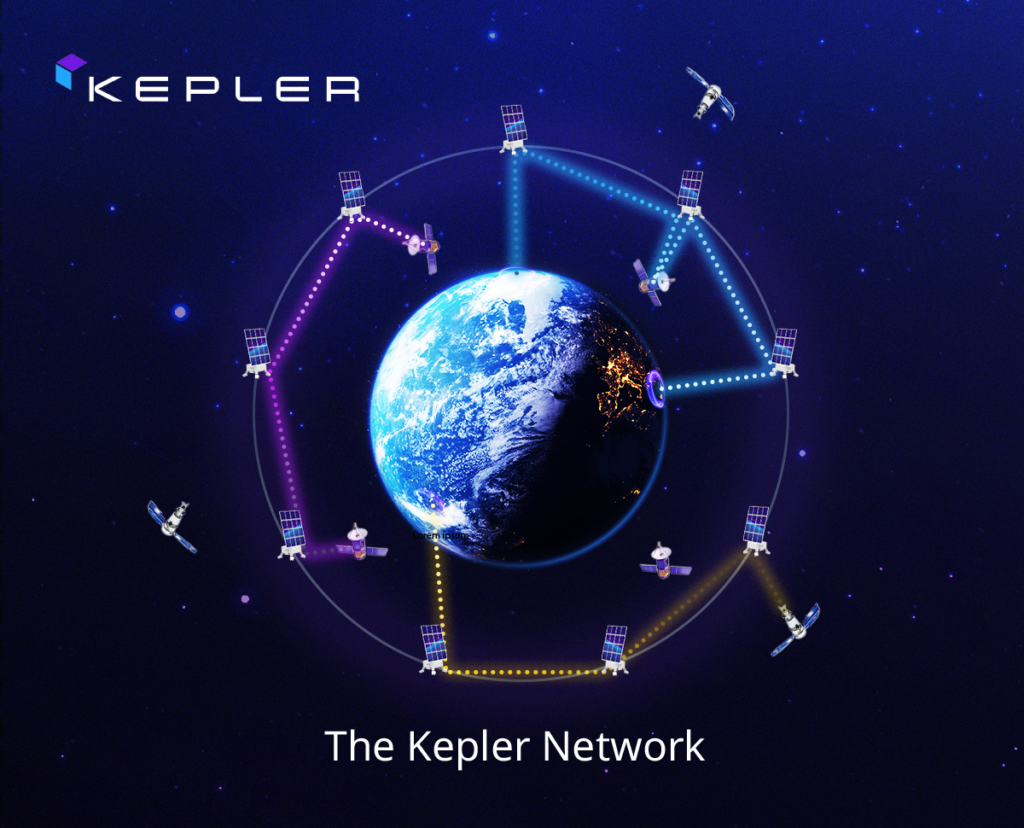
Kepler recently launched two optical Pathfinder satellites equipped not only with RF payloads, but also with two optical communications terminals compatible with the SDA constellation. (Illustration courtesy of Kepler Communications.)
In this Q&A with Robert Conrad, Vice President of US Business Development for Kepler Communications US, we discuss: Kepler’s Space Development Agency (SDA)-compatible space data relay network that will bring modern Internet capabilities to space, its mission to in-orbit connectivity to a constellation of satellites designed to act as orbiting Internet exchange points, and how the hybrid RF/optical network will modernize space communications with low-latency, high-throughput capabilities .
Breaking Defense: Introduce us to Kepler and your latest project.

Robert Conrad is vice president of U.S. business development at Kepler Communications.
Conrad: Kepler is building an optical data relay network for space, called The Kepler Network, that will bring Internet connectivity to space. Our network is compatible with the SDA’s Proliferated Warfighter Space Architecture, enabling interoperability between commercial and government architectures. SDA compatibility allows Kepler to provide resilience for government networks. The Kepler network fits in nicely with what SDA is deploying and what the Defense Innovation Unit is building with its Hybrid Space Architecture program.
One aspect that is very important to the SDA is the ability to connect to commercial remote sensing satellites: Earth observation companies that provide images to the Department of Defense and ultimately to the warfighter. Customers can connect their remote sensing satellites to the Kepler network, which serves as a translation layer between the SDA and commercial Earth observation satellites.
Ultimately, Kepler is a provider of communications data transport. Within our network, our satellites are connected by inter-satellite optical links, allowing us to provide low-latency, sub-minute data transport from satellite acquisition of imagery to delivery to the warfighter.
Breaking Defense: For example, the military needs low-latency, low-Earth orbit communications for on-the-go communications. I assume then that your Internet in Space will support that.
Conrad: That’s right. We can provide low latency solutions for anything that can connect to our network, whether it’s specifically connected to the military from a tactical perspective or even human spaceflight and other space connectivity needs outside of the DoD.
Breaking Defense: Tell us about your existing constellation and space activities.
Conrad: To date, Kepler has launched 21 satellites as part of our first-generation constellation, providing S- and Ku-band point-to-point communications to customers around the world. Many do not realize that we are vertically integrated with in-house manufacturing facilities, allowing us to manage the entire lifecycle of satellite development and operations. We have built our own S-band and Ku-band flight hardware and have significant flight heritage on those radios as part of our technology development roadmap.

Kepler has launched 21 satellites as part of its first-generation constellation, enabling global point-to-point communications in the S- and Ku-band. (Illustration courtesy of Kepler.)
We are very excited about our latest milestone: the launch of two optical Pathfinder satellites, equipped not only with our RF payloads, but also with two optical communications terminals compatible with the SDA constellation. Our Pathfinder satellites will validate inter-satellite optical links, paving the way for the future of the Kepler network.
We are also in discussions with a number of government agencies and commercial providers who are interested in demonstrations and capacity testing of these OCT-equipped satellites, whether for space-to-space optical links.
Breaking Defense: SDA’s Proliferated Warfighter Space Architecture includes the Transport and Tracking Layer satellites that will also use optical communications. Is what they do for ballistic missile warning and tracking similar to what you do with laser communications?
Conrad: There are certain payloads that the SDA flies from a U.S. military perspective that are different than ours, such as Link 16, which allows them to communicate with various assets within the Department of Defense.
The similarity to our network is that their inter-satellite connections and connections to other users in orbit are all optical, so the SDA satellites themselves and other SDA-compatible platforms can connect seamlessly to our network, because our satellites share the same optical standard use communication terminal.
Breaking Defense: Describe the threat scenario that necessitates the need for optical laser communications between satellites.
Conrad: Over the past decade, it is clear that the battlefield has moved into space. The space vantage point enables image collection for a variety of reasons, including civilian applications. Given current global conflicts abroad, the transport of remote sensing satellite data in near real time allows the warfighter to make decisions to protect American interests and lives.
Optical intersatellite connectivity enables data delivery to the end user within minutes of data acquisition. Near-real-time communications are critical to our warfighters, and that’s a key driver of optical technology in defense. There are many other applications, such as human spaceflight and other markets, that also require this low-latency, high-bandwidth solution.
The Kepler network, which will be in orbit and operational by 2025, will provide this high-bandwidth, low-latency connectivity and transport to a variety of customers.
Breaking Defense: What are the technological developments that make the Internet of Space possible?
Conrad: First, access to space has become more affordable from a cost perspective. The barrier to entry is rapidly decreasing as rideshares bring the costs and logistics of satellite launches within the reach of smaller companies. The cost of satellites is also falling dramatically over time for a variety of reasons, including assembly-line production of small satellites.
In terms of optical communications, there have been many demonstrations for some time, including by NASA and ESA, which have led to many technological advances.
Now SDA is coming online and creating an optical standard, pushing optical communications terminal manufacturers to build terminals that are interoperable with each other. This is huge because one-off, custom systems cannot meet every need; mass production and standardization are necessary for widespread acceptance. The industry now has a standard that enables interoperability to enable seamless communication between networks.
Breaking Defense: Are there actual standards right now, something like MOSA in the military?
Conrad: Yes. SDA has developed the standard for optical communications. It is a comprehensive standard currently followed by most U.S. and European optical communications terminal manufacturers, and is supported by SDA prime contractor investments, in-space demonstrations, and eventual operational use.
Breaking Defense: You just opened your first US office. Tell us about that.
Conrad: Kepler, headquartered in Toronto, Canada, is well positioned to serve the US market. We opened the U.S. office to focus on serving the U.S. government and what I call the “U.S. flagship” companies that support the government. We want to be integrated into this network because our space data relay capabilities will add value to a wide range of missions. The capabilities we bring to the U.S. industrial base leverage the engineering we perform in Canada.




